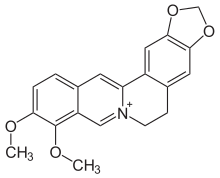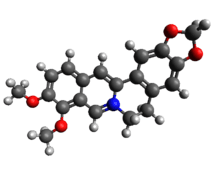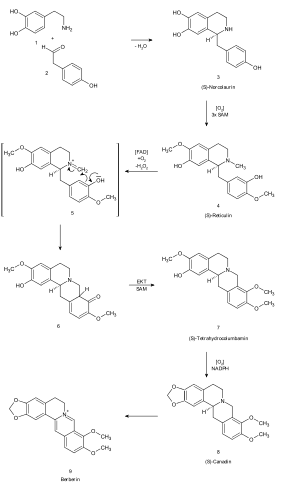Berberine
Berberine is a quaternary ammonium salt from the protoberberine group of benzylisoquinoline alkaloids found in such plants as Berberis (e.g. Berberis vulgaris – barberry, Berberis aristata – tree turmeric, Mahonia aquifolium – Oregon-grape, Hydrastis canadensis – goldenseal, Xanthorhiza simplicissima – yellowroot, Phellodendron amurense[2] – Amur cork tree, Coptis chinensis – Chinese goldthread, Tinospora cordifolia, Argemone mexicana – prickly poppy, and Eschscholzia californica – Californian poppy). Berberine is usually found in the roots, rhizomes, stems, and bark.
 | |
 | |
| Names | |
|---|---|
| Other names
Umbellatine; 5,6-Dihydro-9,10-dimethoxybenzo[g]-1,3-benzodioxolo[5,6-a]quinolizinium | |
| Identifiers | |
CAS Number |
|
3D model (JSmol) |
|
| ChEBI | |
| ChEMBL | |
| ChemSpider | |
| DrugBank | |
| ECHA InfoCard | 100.016.572 |
PubChem CID |
|
| UNII | |
CompTox Dashboard (EPA) |
|
InChI
| |
SMILES
| |
| Properties | |
Chemical formula |
C20H18NO4+ |
| Molar mass | 336.366 g·mol−1 |
| Appearance | Yellow solid |
| Melting point | 145 °C (293 °F; 418 K)[1] |
Solubility in water |
Slowly soluble[1] |
Except where otherwise noted, data are given for materials in their standard state (at 25 °C [77 °F], 100 kPa). | |
| Infobox references | |
Due to berberine's strong yellow color, Berberis species were used to dye wool, leather, and wood. Wool is still dyed with berberine in northern India.[3] Under ultraviolet light, berberine shows a strong yellow fluorescence,[4] so it is useful in histology for staining heparin in mast cells.[5] As a natural dye, berberine has a color index of 75160.
Use in China
Berberine was supposedly used in China as a folk medicine by Shennong around 3000 BC. This first recorded use of berberine is described in the ancient Chinese medical book The Divine Farmer's Herb-Root Classic.[6] The hydrochloric acid salt of berberine is listed as an oral antibacterial in Pharmacopoeia of the People's Republic of China, is a common over-the-counter medication for gastrointestinal bacterial infection.[7] It is usually made into round tablets of 100 milligrams each, with 1-3 pills taken three times a day.[8] Colliqually it is known as huánglián sù (Chinese: 黄连素; literally: 'the essence of Chinese goldthread').
Research
Although the clinical research has been low in quality, studies have been conducted to determine if berberine may affect diabetes[9] or blood lipids.[10][11] As of 2018, there is insufficient evidence to conclude that berberine is safe or effective for any condition.[12] The oral bioavailability of berberine is low.[13]
Berberine is tentatively considered an antibiotic.[14][15] Some research has been undertaken into possible use against methicillin-resistant Staphylococcus aureus (MRSA) infection.[16] A small randomized controlled trial shows that it is effective in diarrhea caused by enterotoxigenic E. coli but not in cholera.[17] Although berberine is used mainly as an antibacterial in China, this aspect of berberine for human use is poorly-reviewed in English literature as of July 2019.
Biosynthesis

The alkaloid berberine has a tetracyclic skeleton derived from a benzyltetrahydroisoquinoline system with the incorporation of an extra carbon atom provided by S-adenosyl methionine via an N-methyl group. Formation of the berberine bridge is readily rationalized as an oxidative process in which the N-methyl group is oxidized to an iminium ion, and a cyclization to the aromatic ring occurs by virtue of the phenolic group.[18]
Reticuline is known as the immediate precursor of protoberberine alkaloids in plants.[19] Berberine is an alkaloid derived from tyrosine. L-DOPA and 4-hydroxypyruvic acid both come from L-tyrosine. Although two tyrosine molecules are used in the biosynthetic pathway, only the phenylethylamine fragment of the tetrahydroisoquinoline ring system is formed via DOPA, the remaining carbon atoms come from tyrosine via 4-hydroxyphenylacetaldehyde. L-DOPA loses carbon dioxide to form dopamine 1. Likewise, 4-hydroxypyruvic acid also loses carbon dioxide to form 4-hydroxyphenylacetaldehyde 2. Dopamine 1 then reacts with 4-hydroxy-phenylacetaldehyde 2 to form (S)-norcolaurine 3 in a reaction similar to the Mannich reaction. After oxidation and methylation by SAM, (S)-reticuline 4 is formed. (S)-reticuline serves as a pivotal intermediate to other alkaloids. Oxidation of the tertiary amine then occurs and an iminium ion is formed 5. In a Mannich-like reaction the ortho position to the phenol is nucleophilic, and electrons are pushed to form 6. Product 6 then undergoes keto-enol tautomerism to form (S)-scoulerine, which is then methylated by SAM to form (S)-tetrahydrocolumbamine 7. Product 7 is then oxidized to form the methylenedioxy ring from the ortho-methoxyphenol, via an O2-, NADPH- and cytochrome P-450-dependent enzyme, giving (S)-canadine 8. (S)-canadine is then oxidized to give the quaternary isoquinolinium system of berberine. This happens in two separate oxidation steps, both requiring molecular oxygen, with H2O2 and H2O produced in the successive processes.[20]
See also
- Coptisine for a related pharmacological discussion
- Goldenseal for a related pharmacological discussion
- Jatrorrhizine, another protoberberine alkaloid
- Sanguinarine, a plant-based compound with very similar chemical classification as berberine
References
- The Merck Index, 10th Ed. (1983), p.165, Rahway: Merck & Co.
- Zhang Q, Cai L, Zhong G, Luo W (2010). "Simultaneous determination of jatrorrhizine, palmatine, berberine, and obacunone in Phellodendri Amurensis Cortex by RP-HPLC". Zhongguo Zhong Yao Za Zhi = Zhongguo Zhongyao Zazhi = China Journal of Chinese Materia Medica. 35 (16): 2061–4. doi:10.4268/cjcmm20101603. PMID 21046728.
- Gulrajani, ML (2001). "Present status of natural dyes". Indian Journal of Fibre & Textile Research. 26: 191–201 – via NISCAIR Online Periodicals Repository.
- Weiß, Dieter (2008). "Fluoreszenzfarbstoffe in der Natur" (in German). Retrieved 17 July 2009.
- "B3251 Berberine chloride form". Sigma-Aldrich. 2013. Retrieved 2 Aug 2013.
- The divine farmer's materia medica : a translation of the Shen Nong Ben Cao Jing. Yang, Shouzhong (1st ed.). Boulder, CO: Blue Poppy Press. 1998. ISBN 9780936185965. OCLC 41048949.CS1 maint: others (link)
- "盐酸小檗碱 (Berberine Hydrochloride)". Pharmacopoeia of the People's Republic of China (in Chinese). 2 (5 ed.). p. 875. ISBN 978-7-5067-7337-9.
- "盐酸小檗碱片说明书". 丁香园用药助手 (in Chinese). Retrieved 15 July 2019.
- Dong H, Wang N, Zhao L, Lu F (2012). "Berberine in the treatment of type 2 diabetes mellitus: a systemic review and meta-analysis". Evid Based Complement Alternat Med. 2012: 591654. doi:10.1155/2012/591654. PMC 3478874. PMID 23118793.
- Ju, Jianqing; Li, Jingen; Lin, Qian; Xu, Hao (15 November 2018). "Efficacy and safety of berberine for dyslipidaemias: A systematic review and meta-analysis of randomized clinical trials". Phytomedicine. 50: 25–34. doi:10.1016/j.phymed.2018.09.212. ISSN 0944-7113. PMID 30466986.
- Dong H, Zhao Y, Zhao L, Lu F (2013). "The effects of berberine on blood lipids: a systemic review and meta-analysis of randomized controlled trials". Planta Med. 79 (6): 437–46. doi:10.1055/s-0032-1328321. PMID 23512497.
- "Berberine: MedlinePlus Supplements". MedlinePlus, National Library of Medicine, US National Institutes of Health. 19 January 2019. Retrieved 15 February 2019.
- Liu CS, Zheng YR, Zhang YF, Long XY (2016). "Research progress on berberine with a special focus on its oral bioavailability". Fitoterapia (Review). 109: 274–82. doi:10.1016/j.fitote.2016.02.001. PMID 26851175.
- "Poster Presentations". FEBS Journal. 277: 37–271. 2010. doi:10.1111/j.1742-4658.2010.07680.x. hdl:10292/2142.
- Li Y., Zuo G.-Y. 'Advances in studies on antimicrobial activities of alkaloids" Chinese Traditional and Herbal Drugs 2010 41:6 (1006–1014)
- Yu HH, Kim KJ, Cha JD, Kim HK, Lee YE, Choi NY, You YO (2005). "Antimicrobial activity of berberine alone and in combination with ampicillin or oxacillin against methicillin-resistant Staphylococcus aureus". Journal of Medicinal Food. 8 (4): 454–61. doi:10.1089/jmf.2005.8.454. PMID 16379555.
- Rabbani, G. H.; Butler, T.; Knight, J.; Sanyal, S. C.; Alam, K. (1 May 1987). "Randomized Controlled Trial of Berberine Sulfate Therapy for Diarrhea Due to Enterotoxigenic Escherichia coli and Vibrio cholerae". Journal of Infectious Diseases. 155 (5): 979–984. doi:10.1093/infdis/155.5.979. PMID 3549923.
- Dewick, P. (2009). Medicinal Natural Products: A Biosynthetic Approach (3rd ed.). West Sussex, England: Wiley. p. 357. ISBN 978-0-471-49641-0.
- Park SU, Facchini PJ (June 2000). "Agrobacterium rhizogenes-mediated transformation of opium poppy, Papaver somniferum l., and California poppy, Eschscholzia californica cham., root cultures". Journal of Experimental Botany. 51 (347): 1005–16. doi:10.1093/jexbot/51.347.1005. PMID 10948228.
- Dewick, P. (2009). Medicinal Natural Products: A Biosynthetic Approach (3rd ed.). West Sussex, England: Wiley. p. 358. ISBN 978-0-471-49641-0.